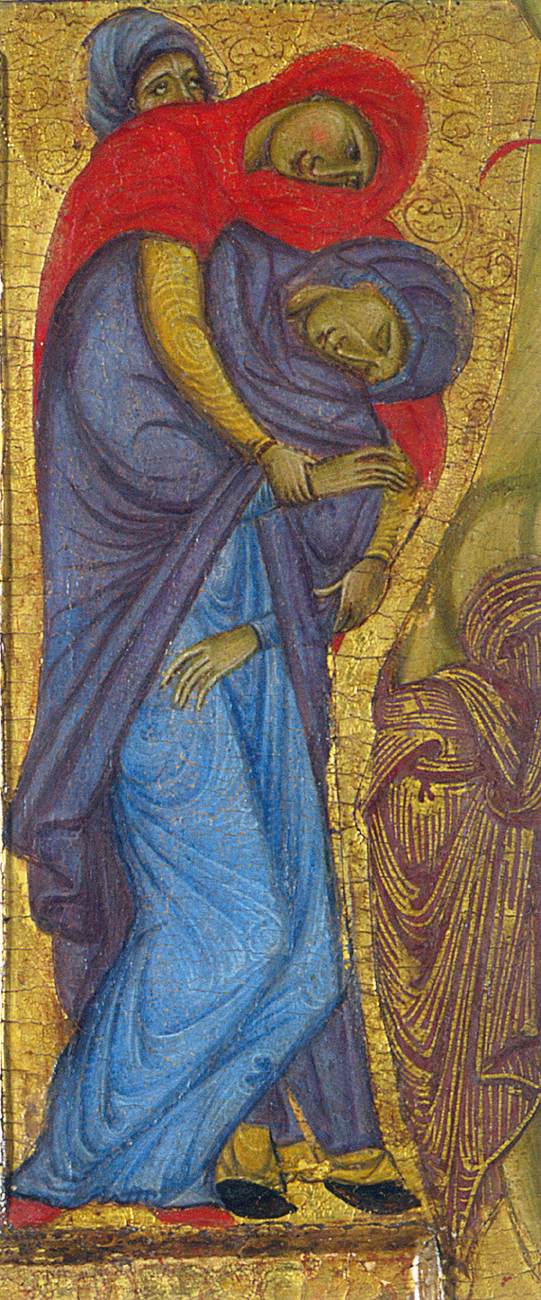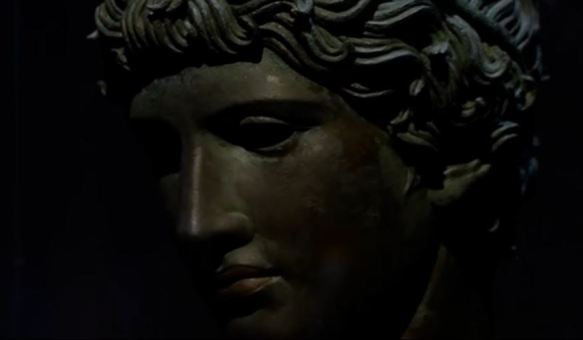Giacobbe Giusti, Master of Saint Francis, Details of a Crucifix (c.1275-80), National Gallery, London

Giacobbe Giusti, Master of Saint Francis, Details of a Crucifix (c.1275-80), National Gallery, London
The Master of Saint Francis (in Italian Maestro di S. Francesco) was an anonymous Italian painter, perhaps of Pisan origin[1] though probably trained in Umbria,[2] working between 1250–1280. His work embodies an important aspect of the contact between Italian and Byzantine art of this period.
Works
A painter of frescoes and panels and, perhaps, designer of stained glass in the district around Perugia, the Master of Saint Francis was given this name by art historian Henry Thode in 1885 and is based on the title of a panel painting, St. Francis with Angels, found in the Basilica of Saint Mary of the Angels in Assisi.[3]
Much of the work attributed to him was part of the early phase in the decoration of Basilica of San Francesco of Assisi, including the fresco cycle in the nave of the Lower Church with five scenes from the Passion of Christ on the right wall and five scenes from the Life of St Francis on the left. (These were damaged by the later opening of the side chapels.) In spite of the obvious participation of assistants, the entire cycle seems to have been planned by a single artist and can be considered as homogeneous and characteristic of his style. The cycle was largely based on the later works of Giunta Pisano but also shows the influence of such Umbrian artists as Rainaldetto di Ranuccio, Simeone and Machilone and of contemporary manuscript illumination, for example the Gospel Book of Giovanni da Gaibena (Padua, Bib. Capitolare). Designs for some of the stained glass windows in the Upper Church are also attributed to him.[4] In addition, he created a large panel painting (now divided into numerous pieces) for the church of Saint Francis al Prato in Perugia,[4] and several painted crosses.
Within his works Byzantine elements, particularly of iconography, are found with western forms of ornamentation and a use of colour that is far from Byzantine.
Giacobbe Giusti, Master of Saint Francis: Crucifix du Louvre (extrait)

The frescoes in the nave of the Lower Church in Assisi are regarded as the masterwork of the Master of St Francis. Unfortunately, half of each has been destroyed when the walls were broken through. These frescoes initiated the decoration in San Francesco around 1260. Before the eyes of the pilgrims visiting the saint’s tomb in the lower church, a pictorial program of an entirely new kind unfurled, juxtaposing five scenes from the Passion of Christ on the north wall (Preparation for the Crucifixion, Crucifixion, Deposition, Lamentation, Supper at Emmaus) with five scenes from the life of St Francis on the south wall (Renunciation of Worldly Goods, Dream of Pope Innocent III, St Francis Preaches to the Birds, St Francis Receives the Stigmata, Funeral of St Francis.
These murals were executed al secco, on dry plaster, using tempera paints in large sections. The artistic qualities of the paintings are difficult to judge as the works have been largely destroyed.
Giacobbe Giusti, Franziskusmeister: Der heilige Franziskus predigt den Vögeln, um 1260.
Meister des Heiligen Franziskus von Assisi oder Franziskusmeister (italienischMaestro di San Francesco) wird ein italienischer Maler unbekannten Namens genannt, der Fresken und womöglich Glasbilder im Gebiet um Perugia in Umbrien, Italien kreierte. Er war aktiv zwischen 1260 und 1280.
Namensgebung
Seinen Notnamen erhielt der Franziskusmeister von dem Kunsthistoriker Henry Thode nach einem Bild in der Kirche Santa Maria degli Angeli in Assisi, das den Heiligen Franz von Assisi mit Engeln darstellt[1].
Werke und Stil
Werke des Franziskusmeister sind vor allem in der Basilika San Francesco in Assisizu sehen, beispielsweise ein Freskenzyklus im Schiff der Unterkirche mit fünf Szenen zur Passionsgeschichte Christi auf der rechten Seite und fünf Szenen aus dem Leben des Hl. Franziskus auf der linken Seite (diese wurden bei der späteren Öffnung der Seitenkapellen beschädigt).
Trotz der möglichen Assistenz von Fremden bei der Erstellung der Werke, scheinen diese doch von einem einzigen Künstler geplant worden zu sein und zeigen einen einheitlichen Stil. Sie basieren wahrscheinlich auf Nachahmungen des späten Giunta Pisano, aber zeigen auch Einflüsse anderer Künstler Umbriens wie zum Beispiel Rainaldetto di Ranuccio, Simeone und Machilone von Spoleto und Einflüsse zeitgenössischer Buchmalereien wie der Bibel von Giovanni da Gaibana von Padua.
Der Meister des Hl. Franziskus verkörpert einen wichtigen Aspekt der Verbindung italienischer und byzantinischer Ikonenmalerei verbunden mit Detailmalerei und Farben, die dem byzantinischen Stil fremd sind.
Einzelnachweise
- ↑ H. Thode: Franz von Assisi und die Anfänge der Kunst der Renaissance in Italien. 2. verbesserte Auflage, G. Grote 1904
Literatur
Saskia Esser: Die Ausmalung der Unterkirche von San Francesco in Assisi durch den Franziskusmeister. Bonn 1983 (Bonn, Rheinische Friedrich-Wilhelms-Universität, Diss., 1983).
- Elvio Lunghi: Una „copia“ antica dagli affreschi del maestro di San Francesco. In: Paragone. Arte. Bd. 40, 1989, ISSN 1120-4737, S. 12–29 (italienisch).
- Joachim Poeschke: Der „Franziskusmeister“ und die Anfänge der Ausmalung von S. Francesco in Assisi. In: Mitteilungen des Kunsthistorischen Institutes in Florenz, Bd. 27, H. 2, ISSN 0342-1201, 1983, S. 125–170.
- Jürgen Schultze: Zur Kunst des „Franziskusmeisters“. In: Wallraf-Richartz-Jahrbuch. 25, 1963, ISSN 0083-7105, S. 109–150.
- Jürgen Schultze: Die Fresken in der Unterkirche von San Francesco zu Assisi und andere Werke des „Franziskusmeisters“. In: Raggi. Bd. 7, 1967 ZDB-ID 528282-2, S. 44–58.
- Henry Thode: Franz von Assisi und die Anfänge der Kunst der Renaissance in Italien. 2. verbesserte Auflage. G. Grote, Berlin 1904.
https://de.wikipedia.org/wiki/Maestro_di_San_Francesco
https://www.wga.hu/frames-e.html?/html/m/master/francis/index.html
























